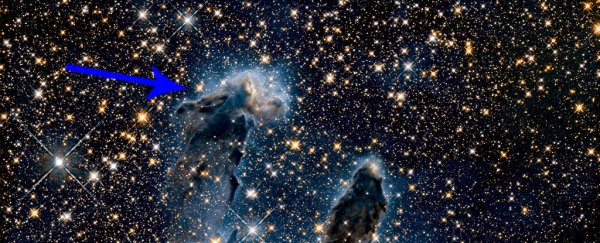NASA and ESA's incredible view of the 'Pillars of Creation', courtesy of the Hubble Space Telescope, has become one of the most iconic views of our cosmos since it was first captured in 1995.
Released as 'image of the day' on April 6, this particular image of the structure in the Eagle Nebula, however, has left us speechless.
It shows the radiating glow of the pillars in infrared light - and you can see the infrared light piercing through dust and gas, giving the pillars a spectacular blueish shadow.
 (NASA, ESA/Hubble and the Hubble Heritage Team)
(NASA, ESA/Hubble and the Hubble Heritage Team)
The 1995 image of the pillars, a composite of three different images compiled using visible light, shows the pillars located in the Eagle Nebula throwing off cool hydrogen gas and cosmic dust.
 The 1995 image of the pillars. (NASA, ESA, STScI, J. Hester and P. Scowen (Arizona State University))
The 1995 image of the pillars. (NASA, ESA, STScI, J. Hester and P. Scowen (Arizona State University))
The newly publicised infrared version is actually not new, but came out when images of this cosmic structure were revisited a few years ago. In 2015, astronomers also assembled a more detailed image captured in visible light.
 (NASA, ESA/Hubble and the Hubble Heritage Team)
(NASA, ESA/Hubble and the Hubble Heritage Team)
First discovered in 1745 by Swiss astronomer Jean-Philippe Loys de Cheseaux, the Eagle Nebula is roughly 7,000 light-years from Earth, a nursery for stars in the Serpens constellation.
At four to five light-years in width, the pillar structure is immense, although it's just a relatively small structure compared to the overall nebula, which spans a staggering 70 by 55 light-years.
Editor's note (16 April 2020): An earlier version of this article noted the infrared image was new; this is incorrect, it was first published in 2015 when NASA and ESA 'revisited' the Eagle Nebula. We apologise for the misunderstanding.
This article was originally published by Futurism. Read the original article.
